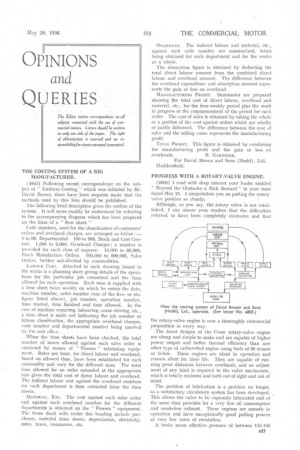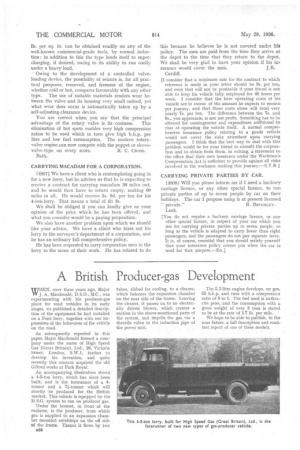OPINIONS
Page 41

Page 42

If you've noticed an error in this article please click here to report it so we can fix it.
and
QUERIES
THE COSTING SYSTEM OF A BIG MANUFACTURER.
L4805] Following recent correspondence on the subject of " Uniform Costing," which was initiated by Mr. David Brown, there have been requests made that the methods used by this firm should be published. .
The following brief description gives the outline of the system. It will more readily be understood by referring to the accompanying diagram which has been prepared on the lines of a " flow sheet." .
Code numbers, used for the classification of customers' orders and overhead charges, are arranged as follow :— 1 to 99, Departmental. 100 to 999, Stock and Cost Control. 1,000 to 9,999, Overhead Charges ; a number is provided for each class of expense; 10,000 to 99,999, Stock Manufacture Orders. 100,000 to 999.999, Sales Orders, further sub-divided by commodities.
LABOUR COST. Attached to each drawing issued to the works is a planning sheet giving details of the operations for the particular job concerned and the time allowed for each operation. Each man is supplied with a time sheet twice weekly on which he enters the date, machine number, order number (one of the fiveor sixfigure listed above), job number, operation number, time started, time finished and time allowed. In the case of machine repairing, labouring, crane driving, etc., a time sheet is made out indicating the job number or labour classification, the appropriate overhead charges, code number and departmental number being inserted by the cost office.
When the time sheets have been checked, the total number of hours allowed against each sales order is extracted by means of " Powers " tabulating equipment. Rates per hour, for direct labour and overhead, based on allowed time, have been established for each commodity and vary for the different sizes. The total time allowed for an order extended at the appropriate rate gives the total cost of direct labour and overhead. The indirect labour cost against the overhead numbers for each department is then extracted from the time sheets.
MATERIAL, arc. The cost against each sales order and against each overhead number for the different departments is obtained on the " Powers " equipment. The items dealt with under this heading include purchases, material from stores, depreciation, electricity, rates, taxes, insurances, etc. OVERHEAD. The indirect labour and material, etc., against each code number are summarized, totals being obtained for each department and for the works as a whole.
The absorption figure is obtained by deducting the total direct labour amount from the combined direct labour and overhead amount. The difference between the overhead expenditure and absorption amount represents the gain or loss on overhead.
MANUFACTURING PROFIT. Summaries are prepared showing the total cost of direct labour, overhead and material, etc., for the four-weekly period plus the work in progress at the commencement of the period for each order. The cost of sales is obtained by taking the whole or a portion of the cost against orders which are wholly or partly delivered. The difference between the cost of sales and the selling value represents the manufacturing profit.
TOTAL PROFIT. This figure is obtained by combining the manufacturing profit and the gain or loss on overheads. R. GARDINER, For David Brown and Sons (Hudd), Ltd. Huddersfield.
PROGRESS WITH A ROTARY-VALVE ENGINE.
148061 I read with deep interest your leader entitled " Beyond the Obstacles a Rich Reward" in your issue dated May 15. I congratulate you on putting the rotary valve position so clearly.
Although, as you say, the rotary valve is not established, I can assure your -readers. that. the difficulties referred to have been cOmpletely Overcome and that
the rotary-valve engine is now a thoroughly commercial proposition in every way.
The latest designs of the Cross rotary-valve engine are cheap and simple to make and are capable of higher power output and better thermal efficiency than any other type of carburefted engine using fuels of 66 Octane or below. These engines are silent in operation and remain silent for their life. They are capable of run. fling great distances between overhauls, and no adjustment of any kind is required to the valve mechanism, which is totally enclosed and both out of sight and out of mind.
The problem of lubrication is a problem no longer, as a satisfactory circulatory system has been developed. This allows the valve to be copiously lubricated and at the same time provides for a very low oil consumption and smokeless exhaust. These engines are smooth in operation and have exceptionally good pulling powers at very low rates of revolution.
A brake mean effective pressure of between .150-160 lb. per sq. in. can be obtained readily on any of the well-known commercial-grade fuels, by normal induction: in addition to this the type lends itself to supercharging, if desired, owing to its ability to run coolly under a heavy load.
' Owing to the development of a controlled valveloading device, the possibility of seizure is, for all practical purposes, removed, and freeness of the engine, whether cold or hot,. compares favourably with any other type. The use of suitable materials renders wear between the valve and its housing very small indeed, yet what wear does occur is automatically taken up by a self-adjusting-clearance device.
You are correct when you say that the principal advantage of the rotary valve is its coolness. This elimination of hot spots enables very high compression ratios to be used which in turn give high b.h.p. per litre and low fuel consumption. The modern rotaryvalve engine can now compete with the poppet or sleeve valve-type on every score. R. C. CROSS. Bath.
CARRYING MACADAM FOR A CORPORATION.
14807] We have a client who is contemplating going in for a new lorry, but he advises us that he is expecting to receive a contract for carrying macadam 30 miles out, and he would then have to return empty, making 60 miles in all. He would receive 5s. 9d. per ton for his 4-ton. lorry. That means a total of 3s.
We shall be obliged if you can kindly give us your opinion of the price which he has been offered, and what you consider would be a paying proposition.
We also have another problem upon which we should like your advice. We have a client who hires out his lorry to the surveyor's department of a corporation, and he has an ordinary full comprehensive policy.
He has been requested to carry corporation men in the lorry to the scene of their work. He has refused to do
this because he believes he is not covered under his policy. The men are paid from the time they arrive at the depot to the time that they return to the depot. We shall be very glad to have your opinion if his in surance would cover the men. J.B. Cardiff.
[I consider that a minimum rate for the contract to which reference is made in your letter should be 9s. per ton, and even that will not be profitable if your friend is not able to keep his vehicle fully employed for 48 ,hours per week. I consider that the bare operating costs of his vehicle are in excess of the amount he expects to receive per journey, and that those costs alone will total very nearly 7s. per ton. The difference between the 7s. and you appreciate, is not net profit Something has to be allowed for contingencies and expenditure additional to that of operating the vehicle itself. A normal comprehensive insurance policy relating to a goods vehicle would not cover the risks attendant upon carrying passengers. I think that the best way to deal with this problem would be for your friend to consult the corporation and to obtain from them, in writing, a statement to the effect that their own insurance under the Workmen's Compensation Act is sufficient to provide against all risks involved in the workmen making this journey.—S.T.R.]
CARRYING PRIVATE PARTIES BY CAR.
[48081 Will you please inform me if I need a hackney carriage licence, or any other special licence, to run private parties of up to seven people by car on their holidays. The car I propose using is at present licensed
"private." R. BRINDLEY. Leek.
[You do not require a hackney carriage licence, or any other special licence, in respect of your car which you use for carrying private parties up to seven people, so long as the vehicle is adapted to carry fewer than eight passengers, and the passengers do not pay separate fares. It is, of course, essential that you should satisfy yourself that your insurance policy covers you when the car is used for that purpose.—En.]




























































































